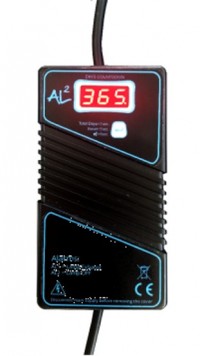Bacteria, Ultraviolet Systems
Ultraviolet (UV) Sterilisation
U.V. is a proven means of addressing microbiologically contaminated waters. This simple and safe technology is suitable for small flow rates i.e. domestic applications and large flows for commercial and industrial uses.How UV Systems Clean Water
These units produce ultraviolet light of between 200 - 295 nanometers (nm) by converting electrical energy through the use of a low pressure mercury vapour lamps. (Commonly called U.V. Bulbs or U.V. Lamps.) These lamps are similar in design to standard fluorescent lamps with a few exceptions. The U.V. lamp is manufactured with Quartz glass which allows for the transmittion of 90% of radiated energy. Fluorescent lamps also contain a thin coating of phosphor inside the lamp which converts the U.V. to visible light.UV Kills Microorganisms in Water
Microorganisms encompass a wide variety of unique structures and can be grouped into five basic groups:- Bacteria
- Virus
- Fungi
- Protozoa
- Algae
In simplest terms, a microorganism is made up of the cell wall, cytoplasmic membrane and the cells genetic material, nucleic acid. It is this genetic material or DNA that is targeted by U.V. light. As the light penetrates the cell wall and cytoplasmic membrane it causes a molecular rearrangement of the microorganism’s and prevents it from reproducing.
If a cell cannot reproduce it is considered dead.
How U.V. Water Sterilisation Works
Water enters through the inlet port in the reactor chamber and flows around a high output U.V. lamp; this lamp emits powerful ultraviolet energy at the 253.7 nm wave length and is protected from contact with the water by a quartz sleeve. The treated water then exits through the outlet port. The design of a U.V is critical to its performance, the flow rate through the unit must allow for proper contact time.Factors affecting U.V.
Suspended solids
This can cause a shielding problem in which a microbe may pass through the unit without having any direct U.V. penetration. This problem can be reduced be mechanical filtration down to at least five microns.Iron/Manganese
Iron will cause staining of the Quartz sleeve with levels as low as 0.03 ppm and levels of manganese should not exceed 0.05 ppm. This staining will inhibit the transmission of U.V. light through the water in the chamber. If these problems exist then pre-treatment will be required.Calcium/Magnesium
These will cause scale to form on the quartz sleeve and will be magnified during times of low or no flow. This scale will inhibit the transmission of U.V. light through the water in the chamber. If these problems are present they can be easily remedied by the use of an ion exchange softener.Other absorbing compounds
Compounds such as humic and fumic acids as well as tannins will reduce the amount of U.V. energy available to penetrate through the water and alter the DNA of the molecule.- Environmentally friendly, no dangerous chemicals to handle or store and no danger of overdosing.
- Low running costs when compared to chemical treatment.
- Immediate treatment, no need for retention times and holding tanks.
- No chemicals added to the water, no change in taste, odour, pH, or conductivity.
- Easy installation.
Installation
The unit should be the last point of treatment and be installed as close to the dispersion point as possible. Since U.V. is a physical process and has no residual value, it is important that all points of the distribution system after the U.V. unit be chemically disinfected to ensure that the system is free from any downstream microbial contamination.Read more in our UV Treatment Brochure
Contact us and our team of technicians will advise and install the best UV system for you with with the minimum of inconvenience and fuss.
Contact Us
For the full range of water filtration & treatment products throughout Kilkenny, Waterford, Tipperary, Kildare, Dublin, Carlow, Meath and Westmeath.Direct Water Treatment
Brittas, Tullaroan, Co.Kilkenny, Ireland.
Email: directwater123@gmail.com
Tel: 056 77 69026
Mob: 087 238 5070
Review Direct Water Treatment on Google
Browse
Water Treatment & Filters
3 Way Taps & Faucets
Well Pumps & Pressure Vessels
Water Testing & Council Grants
Service & Maintenance
Kangan Water Machine Installation
Direct Water Treatment supplies filters including for hard water treatment, water softeners and limescale removal to counties Kilkenny, Waterford, Tipperary, Kildare, Dublin, Carlow, Meath and Westmeath including: County Kilkenny - Ballyragget, Bennettsbridge, Callan, Castlecomer, Fiddown, Freshford, Glenmore, Goresbridge, Gowran, Graiguenamanagh, Inistioge, Johnstown, Kilkenny, Kilree, Knocktopher, Mullinavat, Piltown, Thomastown, Urlingford; County Waterford - Ardmore, Cappoquin, Cheekpoint, Dungarvan, Dunmore East, Kilmacthomas, Lismore, Passage East, Slieverue, Stradbally, Tallow, Tramore, Waterford City, Woodstown; County Tipperary - Annacarty, Ardfinnan, Ballycahill, Ballyporeen, Bansha, Birdhill, Borrisokane, Borrisoleigh, Cahir, Cappawhite, Carrick On Suir, Cashel, Clogheen, Clonmel, Cloughjorden, Dromineer, Dundrum, Emly, Fethard, Golden, Holycross, Kilcash, Killenaule, Lorrha, Marlfield, Monard, Mullinahone, Nenagh, Newcastle, Newport, Newtown, Portroe, Puckaun, Roscrea, Templederry, Templemore, Terryglass, Thurles, Tipperary; County Kildare - Newbridge, NaasTown, Celbridge, Leixlip, Maynooth, Athy, Kildare; County Dublin - Blanchardstown, Blakestown, Fingal, Lucan, Glencullen, Castleknock, Knockmaroon, Tallaght, Jobstown, Balbriggan, Swords, Forrest, Firhouse Village, Clondalkin, Blanchardstown, Coolmine, Clondalkin, Monastery, Tallaght, Springfield, Lucan, St. Helen's, Ashtown, Swords, Lissenhall



